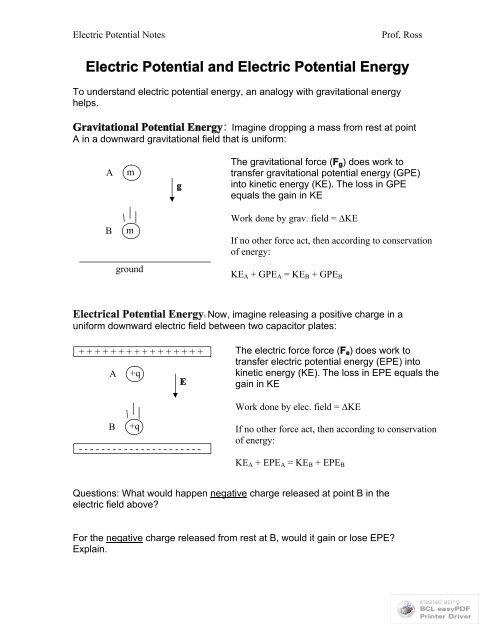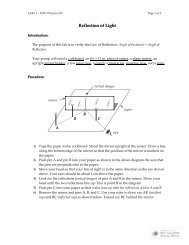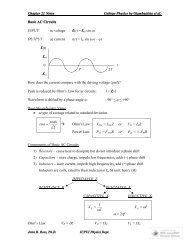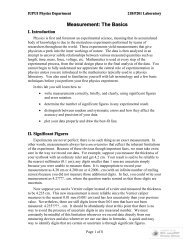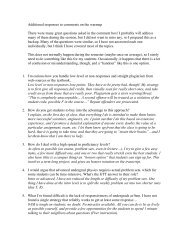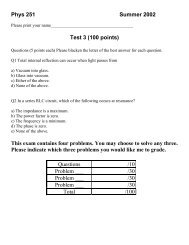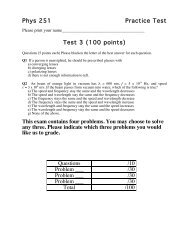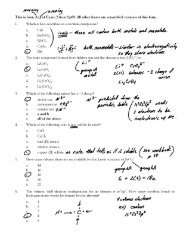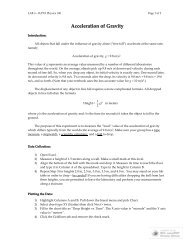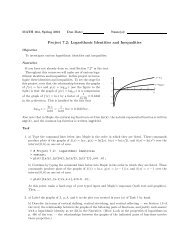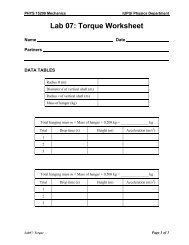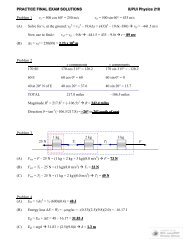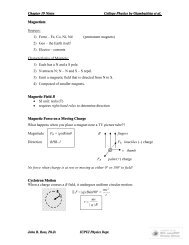Electric Potential and Electric Potential Energy - Web Physics
Electric Potential and Electric Potential Energy - Web Physics
Electric Potential and Electric Potential Energy - Web Physics
You also want an ePaper? Increase the reach of your titles
YUMPU automatically turns print PDFs into web optimized ePapers that Google loves.
<strong>Electric</strong> <strong>Potential</strong> Notes<br />
Prof. Ross<br />
<strong>Electric</strong> <strong>Potential</strong> <strong>and</strong> <strong>Electric</strong> <strong>Potential</strong> <strong>Energy</strong><br />
To underst<strong>and</strong> electric potential energy, an analogy with gravitational energy<br />
helps.<br />
Gravitational <strong>Potential</strong> <strong>Energy</strong>: Imagine dropping a mass from rest at point<br />
A in a downward gravitational field that is uniform:<br />
A<br />
m<br />
g<br />
The gravitational force (F g ) does work to<br />
transfer gravitational potential energy (GPE)<br />
into kinetic energy (KE). The loss in GPE<br />
equals the gain in KE<br />
B<br />
m<br />
Work done by grav. field = KE<br />
If no other force act, then according to conservation<br />
of energy:<br />
ground<br />
KE A + GPE A = KE B + GPE B<br />
<strong>Electric</strong>al <strong>Potential</strong> <strong>Energy</strong>: Now, imagine releasing a positive charge in a<br />
uniform downward electric field between two capacitor plates:<br />
+ + + + + + + + + + + + + + + +<br />
A +q<br />
E<br />
The electric force force (F e ) does work to<br />
transfer electric potential energy (EPE) into<br />
kinetic energy (KE). The loss in EPE equals the<br />
gain in KE<br />
Work done by elec. field = KE<br />
B<br />
+q<br />
- - - - - - - - - - - - - - - - - - - - - -<br />
If no other force act, then according to conservation<br />
of energy:<br />
KE A + EPE A = KE B + EPE B<br />
Questions: What would happen negative charge released at point B in the<br />
electric field above?<br />
For the negative charge released from rest at B, would it gain or lose EPE?<br />
Explain.
<strong>Electric</strong> <strong>Potential</strong> Notes<br />
Prof. Ross<br />
ELECTRIC POTENTIAL (V): <strong>Electric</strong> <strong>Potential</strong> is the ratio of EPE<br />
that a test charge has at a point in space to the value of that test charge.<br />
V EPE<br />
q o<br />
units J /C volt(V )<br />
Because it’s defined in terms of energy, electric potential is a scalar quantity.<br />
However, it may be positive or negative. In the formula, the sign of the test<br />
charge is important. <strong>Electric</strong> potential is an abstract, but very useful, quantity.<br />
Example: The electric potential at a point in space is 9 volts. What is the electric<br />
potential energy of a proton placed at that point?<br />
EPE Vq o<br />
(12 J C )(<br />
Question: The electric potential at a point in space is<br />
9 volts. What is the electric potential energy of an<br />
electron placed at that point?<br />
Imagine a charge accelerating between two points<br />
in space, like points A & B discussed earlier. Using the conservation of energy<br />
EPE A<br />
KE A<br />
EPE B<br />
KE B<br />
EPE A<br />
EPE B<br />
KE B<br />
KE B<br />
q o<br />
V A<br />
q o<br />
V B<br />
KE<br />
q o<br />
(V A<br />
V B<br />
) KE<br />
q o<br />
(V B<br />
V A<br />
) KE<br />
q o<br />
V KE<br />
Using the work-energy theorem:<br />
W E<br />
KE q o<br />
V<br />
The equation above represents the work done by the electric force in<br />
accelerating a charge between two points. If an external agent controls the<br />
motion of a charge between two points in an electric field, it will work against the<br />
electric field. The sign will be opposite as follows:<br />
W external force<br />
W E<br />
KE q o<br />
V<br />
<br />
V is called the <strong>Electric</strong> <strong>Potential</strong> Difference (units: J/C=V) <strong>and</strong> it represents<br />
the Joules of electric potential energy transferred to or away from a Coulomb of<br />
charge passing between two points.
<strong>Electric</strong> <strong>Potential</strong> Notes<br />
Prof. Ross<br />
Example: A proton is released from rest<br />
at point A in the capacitor shown to the<br />
right. Plate A is at a potential of 12 V <strong>and</strong><br />
plate B is “grounded” with an assumed<br />
potential of 0 V. How fast will the proton<br />
be moving when it arrives at B?<br />
+ + + + + + + + + + + + + + + + 12 V<br />
A p+<br />
E<br />
B p+<br />
- - - - - - - - - - - - - - - - - - - - - -<br />
0 V<br />
EPE A<br />
KE A<br />
EPE B<br />
KE B<br />
q p <br />
V A<br />
KE A<br />
q o<br />
V B<br />
KE B<br />
q p <br />
V A<br />
0 0 1 2 m p v 2<br />
v <br />
2q p V A<br />
2(1.603 1019 C)(12J /C)<br />
m p <br />
1.67 10 27 kg<br />
4.8 10 4 m /s<br />
Question: How much work is done by the electric field as it accelerates the<br />
proton?<br />
Question: How much work is done by an external agent to move an electron<br />
constantly from A to B?<br />
The Electron-volt (eV) is another unit for energy that is convenient to<br />
use when dealing with fundamental charges. It is defined as the kinetic energy<br />
that an electron gains as it accelerates through a potential difference of 1 Volt.<br />
1 eV = 1.602 X10 -19 J<br />
In the previous question, the work would be:<br />
1eV<br />
W AB<br />
1.92 10 18 J(<br />
1.602 10 18 J ) 12.0eV
<strong>Electric</strong> <strong>Potential</strong> Notes<br />
Prof. Ross<br />
The relationship between the<br />
<strong>Electric</strong> Field <strong>and</strong> a changing<br />
potential<br />
The work done moving a positive charge<br />
from Point A to point B in the capacitor<br />
shown can be calculated in two ways:<br />
W E<br />
F e<br />
s F e<br />
scos(0 o ) (F e<br />
)s (q o<br />
E)s<br />
Equating these two expressions:<br />
<strong>and</strong><br />
W E<br />
q o<br />
V<br />
+ + + + + + + + + + + + + + + +<br />
A<br />
E<br />
B<br />
C<br />
- - - - - - - - - - - - - - - - - - - - - -<br />
s<br />
q o<br />
E s q o<br />
V<br />
E V<br />
s<br />
unit V m<br />
This expression for the electric field is known as the “potential gradient.” The<br />
greater the change in electric potential per meter, the greater the strength of the<br />
electric field.<br />
Question: Show that a V/m = N/C.<br />
How much work would it take to move the charge from B to C? This can be<br />
shown to be zero in two ways:<br />
W E<br />
F e<br />
s F e<br />
scos(90 o ) 0 <strong>and</strong> W E<br />
q o<br />
V q o<br />
(0) 0<br />
The total work from A to C may be found as follows:<br />
W AC<br />
W AB<br />
W BC<br />
W AB<br />
0 W AB<br />
The total work done by the electric field is independent of path because the<br />
electric force is a conservative force.<br />
Question: The potential difference between two capacitor plates is 12V <strong>and</strong> they<br />
are spaced 2.0mm apart. What is the magnitude of the electric field between the<br />
plates?
<strong>Electric</strong> <strong>Potential</strong> Notes<br />
Prof. Ross<br />
Visualizing <strong>Electric</strong> <strong>Potential</strong> & <strong>Energy</strong><br />
Imagine two conductors, one hollow <strong>and</strong> one solid. The hollow conductor on the<br />
left is grounded (0V) <strong>and</strong> the conductor on the right is at 12 V.<br />
O V<br />
12 V<br />
The potential increases from the left conductor to the right conductor. If we<br />
measure the potentials at many points between the conductors, we can plot the<br />
potentials in a 3-dimensional graph as shown:<br />
<strong>Electric</strong> <strong>Potential</strong> L<strong>and</strong>scape<br />
14<br />
12<br />
12-14<br />
10<br />
10-12<br />
20<br />
16<br />
y-position (cm)<br />
12<br />
8<br />
4<br />
0<br />
0<br />
3<br />
6<br />
9<br />
12<br />
15<br />
18<br />
21<br />
24<br />
x-postion (cm)<br />
8<br />
6<br />
4<br />
2<br />
0<br />
Voltage (V)<br />
8-10<br />
6-8<br />
4-6<br />
2-4<br />
0-2<br />
Where would you expect the electric field to be the greatest magnitude? According to the<br />
potential gradient formula, it would occur where V/s is the greatest which is where the<br />
graph’s slope is the steepest. This appears to be at the front 2 corners of the triangular<br />
conductor (sharp points…this explains lightning rods).<br />
Questions:<br />
Does the electric field point uphill or downhill? Explain.<br />
Which way would a proton accelerate if placed in between the conductors?<br />
Which way would an electron accelerate if placed in between the conductors?<br />
Would the electron or the proton have a greater magnitude of acceleration? Explain.
<strong>Electric</strong> <strong>Potential</strong> Notes<br />
Prof. Ross<br />
The <strong>Electric</strong> potential in the vicinity of point charges:<br />
In the region around a point charge the electric potential is:<br />
1) directly related to q (the value of the charge, sign is important)<br />
2) inversely related to r (the distance from the point charge)<br />
It can be derived using calculus that:<br />
V kq r<br />
where V 0 at r <br />
The potential is positive close to positive point charges <strong>and</strong> negative close to<br />
negative point charges<br />
+q -q<br />
Low V<br />
(less +)<br />
High V<br />
(more +)<br />
High V<br />
(less -)<br />
Low V<br />
(more -)<br />
•Positive test charges place in an electric field will ALWAYS tend to accelerate<br />
from regions of high potential to regions of low potential (i.e., they accelerate in<br />
the direction of the electric field).<br />
•Negative test charges place in an electric field will ALWAYS tend to accelerate<br />
from regions of low potential to regions of high potential. (i.e., they accelerate<br />
opposite to the direction of the electric field).<br />
Example: a) Determine the electric potential at a distance of 3.0m from a -18C<br />
point charge.<br />
V kq r (8.99 10 9 Nm 2<br />
C )(18 2 106 C)<br />
3.0m<br />
5.4 10 4 V<br />
Notice that the denominator is NOT squared like it is for force <strong>and</strong> fields.<br />
b) What is the electric potential energy of a +2.0C charge placed at the same<br />
point?<br />
EPE q o<br />
V (2.0 10 6 C)(5.4 10 4 J /C) 0.11J<br />
A negative EPE means that, relative to a zero EPE infinitely far away from the<br />
negative point charge, the +2.0C charge is at a lower EPE. It will tend to<br />
accelerate toward the negative point charge to even lower potentials.<br />
Question: Determine the sign of the EPE for a negative test charge placed at the<br />
same position. Explain the sign.
<strong>Electric</strong> <strong>Potential</strong> Notes<br />
Prof. Ross<br />
<strong>Electric</strong> <strong>Potential</strong> from multiple point charges<br />
Write an expression for the total electric potential at point P in each figure<br />
-2q<br />
P<br />
-q<br />
d<br />
d<br />
-2q<br />
+q<br />
P<br />
d/2<br />
d/2<br />
-2q<br />
P<br />
d<br />
d<br />
+q<br />
P<br />
d<br />
+2q<br />
d/2<br />
+q<br />
-18q<br />
+q<br />
d<br />
3d<br />
P
<strong>Electric</strong> <strong>Potential</strong> Notes<br />
Prof. Ross<br />
Total <strong>Electric</strong> <strong>Potential</strong> from multiple point charges<br />
Numerical Example<br />
50.0 cm<br />
+10.0 nC A<br />
B<br />
-5.00 nC<br />
20.0 cm<br />
Calculate the total electric potential at point A in above.<br />
d<br />
10.0 cm<br />
The total potential is the scalar sum (with the proper sign) of the potential from each neighboring<br />
point charge:<br />
V Total<br />
<br />
V Total<br />
V A 10<br />
V A5<br />
kq 10<br />
r 10<br />
kq 5<br />
r 5<br />
Nm 2<br />
(8.99 10 9 C )(10.0 Nm 2<br />
2 109 C) (8.99 10 9<br />
<br />
C )(5.00 2 109 C)<br />
0.200m<br />
0.300m<br />
V Total<br />
449.5V 149.8V 300.V<br />
Question #1: Show that the total potential at point B is -225V.<br />
Question #2: If an electron is released from rest at point B (-225 V), show that its<br />
speed reaches 1.36X10 7 m/s when it reaches point A (300 V).<br />
Question #3: Show that the average electric field between A <strong>and</strong> B is 2600N/C<br />
Fill out the following table with the correct signs (+ or -):<br />
Proton going from high V to low V<br />
Proton going from low V to high V<br />
Electron going from high V to low V<br />
Electron going from low V to high V<br />
V W E W ext KE EPE
<strong>Electric</strong> <strong>Potential</strong> Notes<br />
Prof. Ross<br />
Equipotential Lines & Surfaces<br />
Regions of constant potential<br />
+Q -Q<br />
•The equipotential lines for the two point charges are concentric circles.<br />
•The equipotential lines have no direction <strong>and</strong> don’t have arrows.<br />
•The equipotential lines must be perpendicular to the electric field lines<br />
(E=V/s=0 because V=0 along an equipotential by definition, so there is no<br />
component of the electric field in the direction on the equipotentials).<br />
•No work is done by the electric field when charges are moved along an<br />
equipotential (W E =-q 0 V=0), just like the gravitational field does no work when a<br />
hiker walks along contour lines indicated on a map (W g =mgh=0).<br />
Conductive surfaces in Equilibrium:<br />
•The electric field must be perpendicular to the surface, otherwise free electrons<br />
would be accelerating parallel along the surface <strong>and</strong> it wouldn’t be in equilibrium.<br />
This implies that the surface of the conductor is an equipotential.<br />
•<strong>Electric</strong> shielding occurs for all conductors at equilibrium, therefore the electric<br />
field must be ZERO inside the conductor. This implies that the entire conductor<br />
is an equipotential at equilibrium! All points on <strong>and</strong> inside the conductor are at<br />
constant potential.<br />
Look back the “Visualizing <strong>Electric</strong> <strong>Potential</strong> <strong>and</strong> <strong>Energy</strong>” example. Here is the<br />
corresponding equipotential diagram. Answer the questions below:<br />
How much work would it take to move an<br />
electron up the 12cm line between the<br />
plates? How about within the conductors?<br />
QuickTime <strong>and</strong> a<br />
TIFF (LZW) decompressor<br />
are needed to see this picture.<br />
How can you visualize where the electric<br />
field is the greatest on the diagram?<br />
What can you say about the electric field within the solid<br />
triangular conductor on the right? How about the electric<br />
potential?<br />
What can you say about the electric field<br />
within the hollow rectangular conductor?<br />
How about the electric potential?
<strong>Electric</strong> <strong>Potential</strong> Notes<br />
Prof. Ross<br />
Capacitors<br />
Capacitors consist of two parallel metal plates separated by an insulator. A power<br />
supply moves electrons from one plate to another such that one plate obtains a<br />
charge of +q <strong>and</strong> the other –q. The bigger the potential difference between the<br />
plates, the more charge that is separated.<br />
q (C)<br />
Equation for line:<br />
Slope = Capacitance (C)<br />
units=C/V=farad (F)<br />
V<br />
(V)<br />
y = mx + b<br />
q = CV + 0<br />
q = CV<br />
The capacitance (slope) remains constant for a given capacitor, so changes in the<br />
potential difference <strong>and</strong> charge will NOT affect the capacitance (i.e., the charge to<br />
voltage ratio stays the same). The only way to change the capacitance is to alter the<br />
geometry <strong>and</strong> the materials within the capacitor.<br />
Capacitance depends--<br />
1) directly on the area of each plate (A) (but not both plates added together)<br />
2) inversely on the spacing between the plates (d)<br />
3) directly on the dielectric constant (represented by ). This is a unitless quantity<br />
that represents the type of insulator (dielectric) between the plates. The insulator<br />
gets polarized <strong>and</strong> allows more charge to be stored on the plates with less V.<br />
Some representative values are:<br />
vacuum =1.00000<br />
air =1.00054<br />
paper =3.3<br />
C oA<br />
d<br />
where o<br />
8.85 10 12 C 2<br />
Nm 2<br />
o is called the “permittivity of free space” <strong>and</strong> is related to the electric constant k (don’t<br />
get this mixed up with the dielectric constant ) as follows:<br />
k 1<br />
4 o<br />
Questions: What happens to the capacitance of a capacitor when—<br />
a) its plate area is tripled?<br />
b) the distance between the plates is doubled?<br />
c) the charge on the plates is doubled?<br />
d) a vacuum between the plates is replaced with paper (keeping the distance the same)?
<strong>Electric</strong> <strong>Potential</strong> Notes<br />
Prof. Ross<br />
Capacitor Example: A capacitor stores 5.3C of charge when connected to a 6.0-<br />
V battery. The plates are circles with a radius of 0.78m <strong>and</strong> they are separated by paper.<br />
a) How much charge does it store when connected to a 9.0-V battery?<br />
C q 6<br />
V 5.3 106 C<br />
88.33F<br />
6.0V<br />
q 9<br />
CV (88.33F)(9.0V ) 8.0C<br />
Notice that the capacitance stayed the same, regardless of charge or potential difference.<br />
b) What is the distance between the circular plates?<br />
C oA<br />
so d oA<br />
d<br />
C o( r 2 )<br />
C<br />
C 2<br />
(8.85 10 12<br />
d <br />
Nm 2 )(3.3) (0.78)2 m 2<br />
<br />
7.0m<br />
8.0 10 6 F<br />
<strong>Energy</strong> Storage in Capacitors<br />
It takes work to charge a capacitor, <strong>and</strong>, as a result, energy is stored in the<br />
capacitor’s electric field. To charge an uncharged capacitor to a final charge Q, a<br />
potential difference must be applied across the plates. As the amount of charge<br />
increases, the potential difference across the plates increases as shown.<br />
V<br />
V<br />
V ave =<br />
V/2<br />
Since the potential difference builds up<br />
linearly with chart, we must use the<br />
average V to find the amount of work<br />
needed to charge the capacitor:<br />
W=Q(V ave )=Q (V/2)<br />
Since Q=CV,<br />
0<br />
Q<br />
q<br />
E capac =1/2CV 2 =Q 2 /2C<br />
Question: A capacitor stores 5J of energy when connected to a potential difference of 12<br />
Volts. How much energy does it store when connected across a 24V potential<br />
difference?<br />
<strong>Energy</strong> Density in Capacitors<br />
<strong>Energy</strong> density for a capacitor is a measure of the energy in its electric field per<br />
volume of space. For plate distance d <strong>and</strong> area A, the volume within the<br />
capacitor is Volume=Ad<br />
E capac<br />
1 2 C(V )2 1 2 (C)(Ed)2 1 2 ( oA<br />
d )(Ed)2 1 2 o(Ad)E 2 1 2 o(Volume)E 2<br />
E capac<br />
Volume 1 2 oE 2


